Royal Caribbean
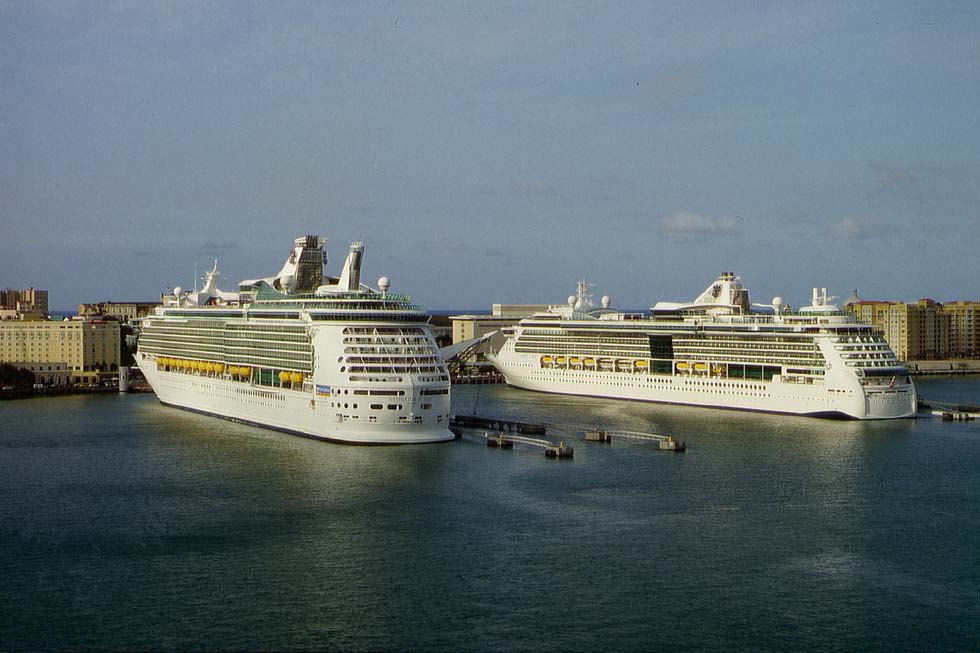
“Navigator of the Seas”, Voyager class and (right) “Jewel of the Seas”, Radiance class, at San Juan, Puerto Rico 2007 (WS)
Download this picture with 1500 x 1000 pix, 300 dpi

In the 1960s not exclusively Arison and Kloster, but also the American Edwin Stephan saw the future market for new cruise ships in the Caribbean. He persuaded the representatives of three Norwegian shipping dynasties to invest into that market. So the Royal Caribbean Cruise Line of Oslo was set up in 1968/69 by A. Wilhelmsen, I.M. Skaugen and Gotaas Larsen (see Ships Monthly, 1/2012). The fleet, specialized exclusively in Caribbean cruises out of Miami, was built up with new ships, the “Song of Norway” (1972/18,416 gt then 23,005 gt), the “Nordic Prince” (1971/18,436 gt, then 23,200 gt) and the “Sun Viking” (1972/18,559 gt), all the three sisters characterized by the ‘skybar’ integrated into the funnel. The “Song of America” (37,584 gt) of 1982 with an even bigger ‘skybar’ showed new dimensions. An unprecedented period of growth began and operations were extended. In 1988 Royal Caribbean Cruise Line merged with Admiral Cruises, founded in 1986. Then Admiral Cruises was fully integrated and the “Future Seas”, commissioned by that company, was completed in 1990, becoming the “Empress of the Seas” (48,563 gt) of Royal Caribbean Cruises. During that period, Royal Caribbean, with 8 ships and a capacity of c.10,000 berths, was number three behind Holland America (c.15,000 berths) and P&O Princess (c.11,000 berths), ahead of Kloster (c.9,000 berths), according to La Vie du Rail of 1989. In 1993 Royal Caribbean became a publicly traded company, enabling to order more megaships.
From 1995 the first vessels were sold, the “Song of Norway”, “Nordic Prince” and “Song of America” to Airtours, later becoming the “Dream Princess”, “Aquamarine” and “Thomson Destiny”, owned by Louis Cruise Lines. The “Dream Princess” was chartered by Caspi Cruises as “Dream”, based at Haifa, Israel, and in 2008 the ship changed to the Peace Boat Organization as “Clipper Pacific”, given away after some months in favour of the “Mona Lisa”. The “Sun Viking” was sold to Star Cruises, becoming the “Superstar Sagittarius”.
In 1997 Royal Caribbean acquired renowned Celebrity Cruises (see next chapter) and in the same year the parent company was renamed Royal Caribbean Cruises Ltd, abbreviated RCCL, with a market share of more than 20% worldwide the number two behind rivaling Carnival Corporation. The main branch of RCCL was labeled Royal Caribbean International, but also Celebrity Cruises preserved its identity. A two year’s struggle of RCCL for taking over P&O Princess Cruises ended in 2003 in favour of rival Carnival. In 2006 however, RCCL succeeded in acquiring Pullmantur of Spain.
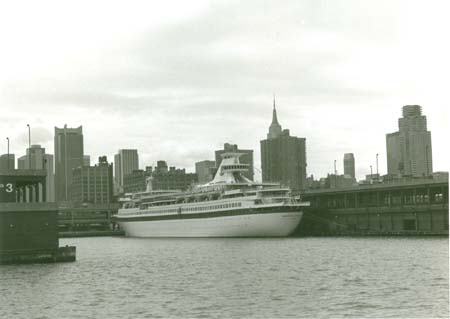
“Nordic Prince” of Royal Caribbean, New York 1987 (WS)
|
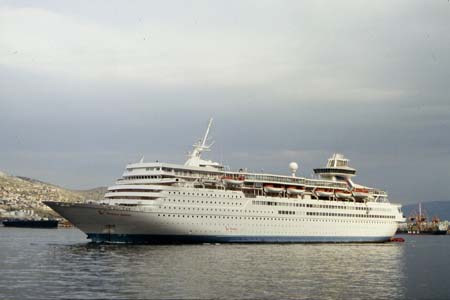
The former “Song of America” as “Thomson Destiny”, Piraeus 2006 (WS)
|
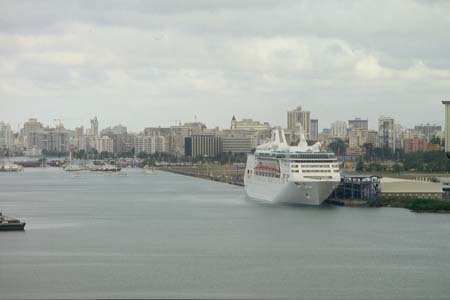
“Empress of the Seas”, commissioned by Admiral Cruises, San Juan 2007 (WS)
|
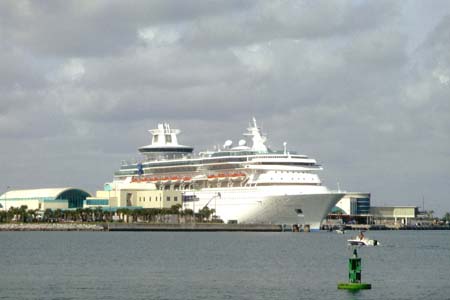
“Sovereign of the Seas”, Port Canaveral 2008 (WS)
|
Royal Caribbean International
Royal Caribbean targeted to own always the most innovative ships. The “Sovereign of the Seas”, completed in 1988 at Saint-Nazaire, was with her 73,192 gt world’s largest passenger ship built in half a century. The Viking Crown Lounge was already a tradition, but ‘The Centrum’, a five-story atrium, and Vegas-style shows were new attractions. With the slightly smaller Vision class, a more elegant positioning of the Viking Crown Lounge (on the last four sisters slightly different) became standard. The Vision class, initially built at Saint-Nazaire, was the first to show the typical Royal Caribbean appearance.
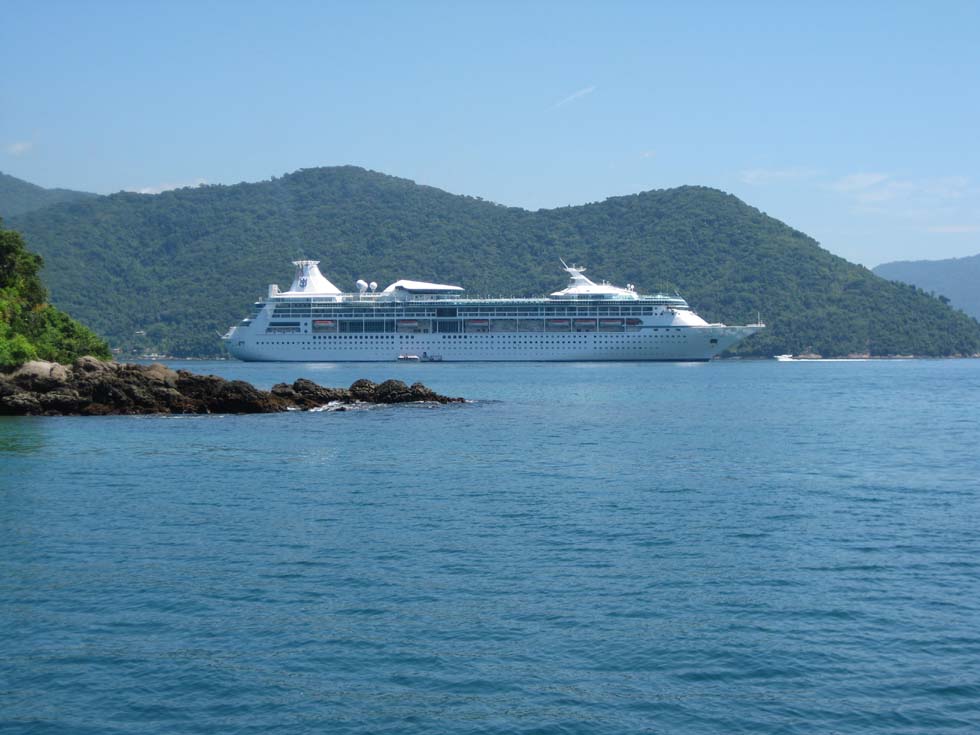
“Vision of the Seas” at Ilha Grande, Brazil 2010 (Anton Soelch)
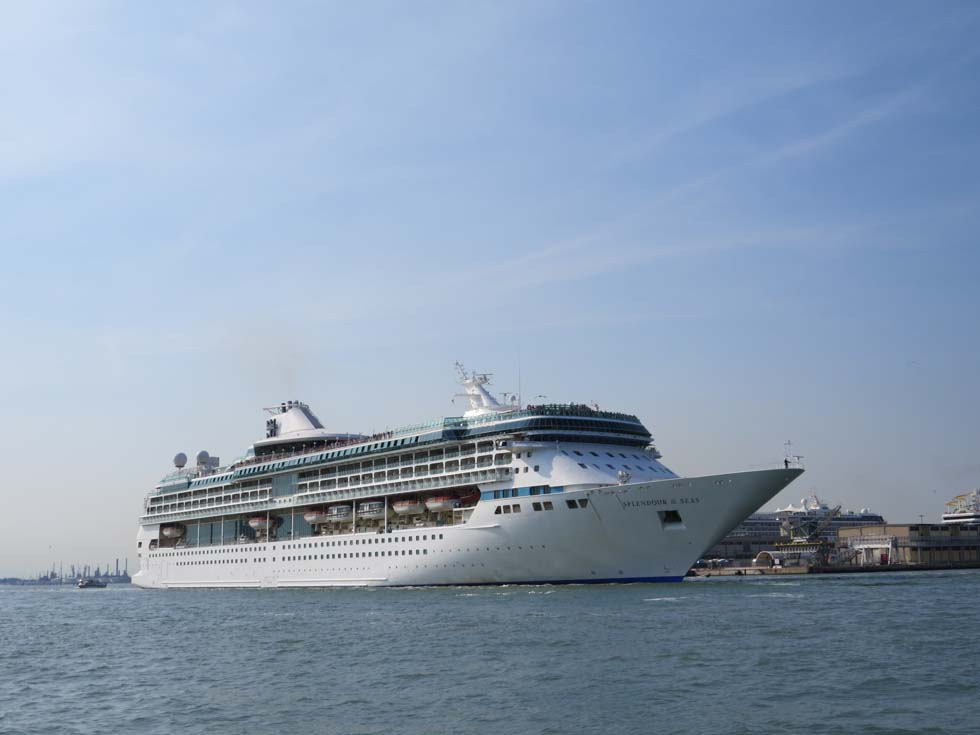
“Splendour of the Seas”, Venice 2013 (WS)
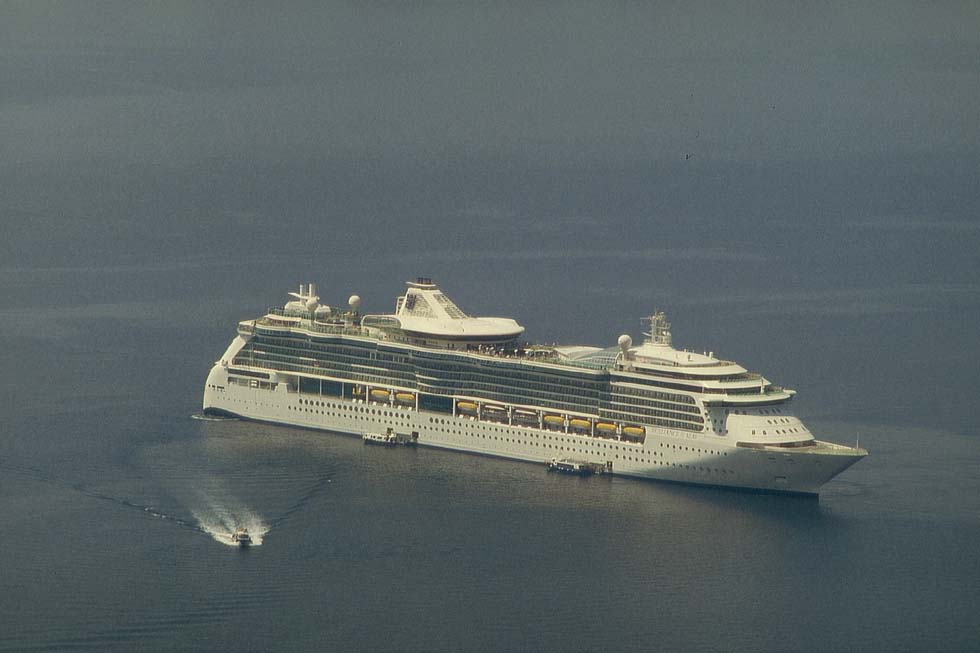
“Brilliance of the Seas”, Radiance class, Santorini 2007 (WS)
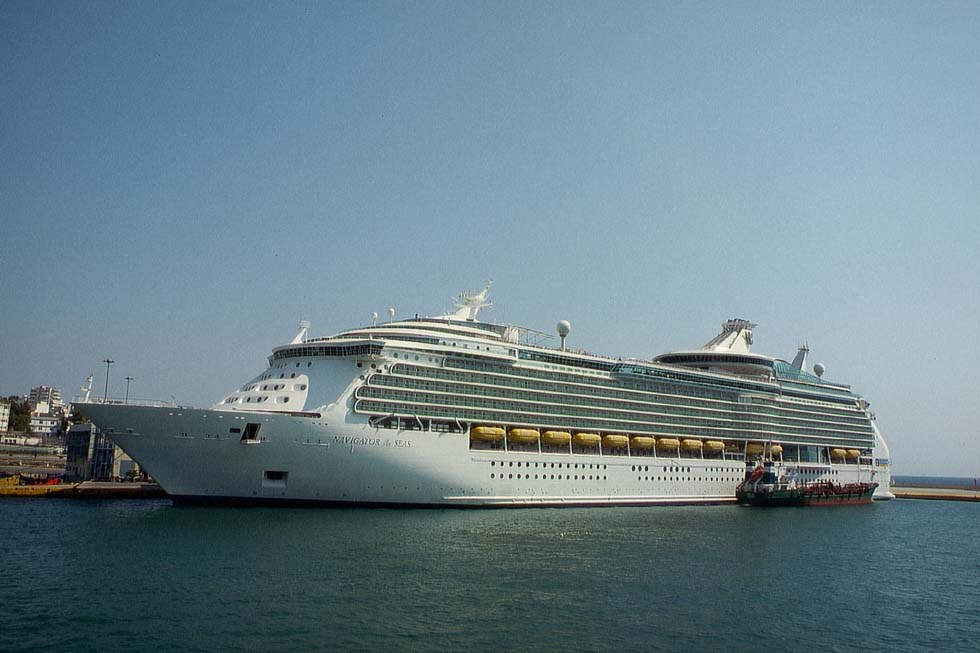
“Navigator of the Seas”, Voyager class, Piraeus 2008 (WS)
For the next class a size of c.85,000 gt was intended, but then this Voyager class of 1999 represented world’s largest passenger ships with c.137,000 gt. Built at Kvaerner Masa Yards in an extremely short time, the vessels, driven by 2 Azipods and 1 ‘Fixipod’ in the center, were the most innovative ones with the four-storey Royal Promenade, connecting the two atriums. It was a difficult task for Harri Kulovaara, since 1995 the chief naval architect of Royal Caribbean, and his team, to include that boulevard into the superstructure, necessitating a sophisticated steel structure. It can be considered the most outstanding interior design innovation since the “Normandie” had been built in pre-war years at Saint-Nazaire, not equaled by any other ship. In connection with the light ‘Scandinavian’ style it became the typical feature of Royal Caribbean. The ship’s extended public space caused a relatively high passenger/space ratio of 45.5 compared to the Carnival Conquest class’s more economic ratio of 37. The rock-climbing wall, the wedding chapel, downstairs an ice-skating rink for excellent ice-shows, the three-storey main dining-room, the 3-storey show-room and a bridge that allows the guests to watch the crew steering the ship were other innovations. The Radiance class, smaller and sleek, built by Meyer Werft with gas-turbine engines and 2 pods, good for a speed up to 25 knots, is characterized by a six-storey portside atrium with a glass wall facing the sea. After the “Queen Mary 2” of rivaling Carnival Corporation had been built as world’s largest passenger ship, Royal Caribbean’s answer became the “Freedom of the Seas”, slower, but with 154,407 gt even larger. She is an extended version of the Voyager class with all their innovative features. Three ships were completed between 2006 and 2008 and there was interest in a fourth one.
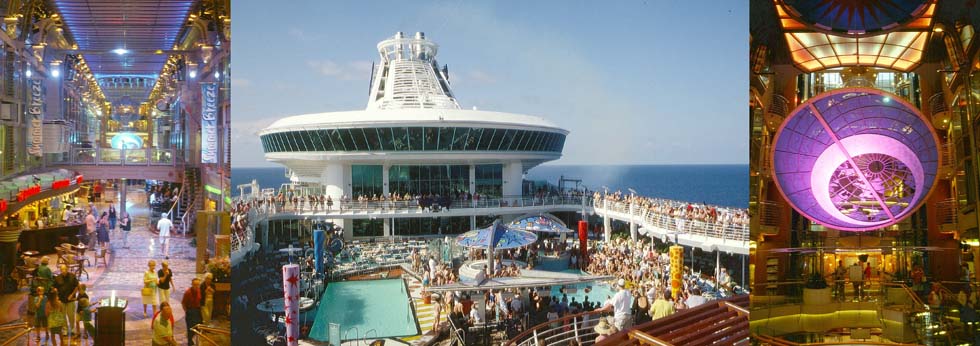
“Mariner of the Seas” (WS)
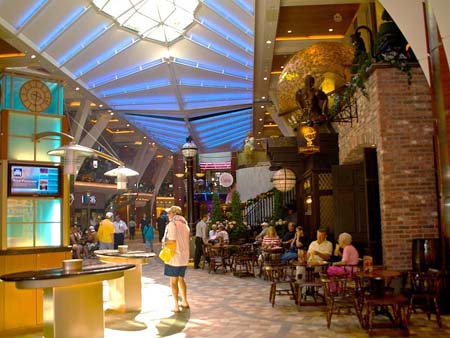
“Oasis of the Seas”, Royal Promenade (Nick Hobygood, via Wikipedia)
|
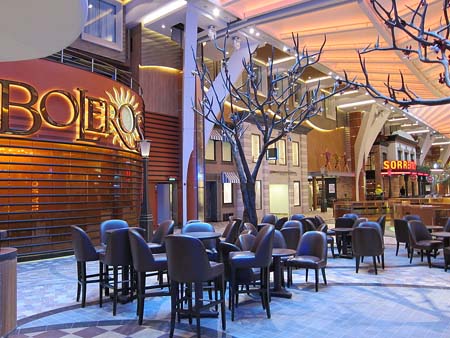
“Allure of the Seas” at STX Europe, Turku 2010 (Makele-90, via Wikipedia)
|
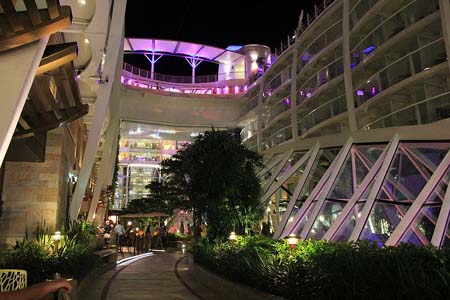
“Oasis of the Seas”, Central Park (flickr.com/photos/navin75, via Wikipedia)
|
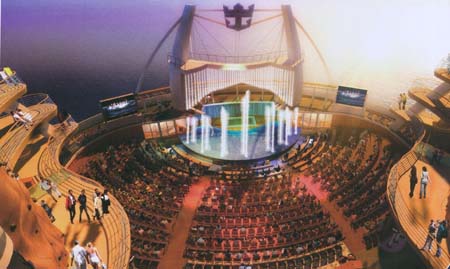
“Oasis of the Seas”, Aquatheater (advertisement Royal Caribbean)
|
ShipPax Statistics & Outlook 06 had informed, that “…in February 2006, Royal Caribbean entered a new and larger generation rather than extending the ‘Freedom’ series”. The Aker Yards Web site stated: “Royal Caribbean orders a new generation of cruise vessel from Aker Yards (…). The 220,000 GRT ship, a prototype developed under the Project Genesis, will be delivered from Aker Yards, Finland, in autumn 2009”. Exceeding the tonnage of the predecessors by 40%, the giant, christened “Oasis of the Seas”, became world’s largest passenger ship, 16 decks high, leaving every other vessel far behind. In 2007 Royal Caribbean International, in passenger numbers for the first time slightly ahead of Carnival Cruise Lines, exercised option to build a second ship of this type, the “Allure of the Seas”. For the 225,282-ton “Oasis of the Seas” a price of $1.24 billion was reported. Compared to the Freedom class they have dimensions of 360m by 47m against 339 by 38.6, a lower-berth capacity of c. 5,400 against 3,634 and a maximum of c.6,300 passengers. Eight Wartsila diesel gensets of 17,500hp each generate the electric power of c.103,000kW for onboard need and for driving three Azipods, all azymuthing, good for a speed of 22.6 knots.
The ships were built by STX Europe in Finland under leadership of vice president Harri Kulovaara, Martin Landtmann and project director Toivo Ilvonen. The attempt was undertaken to preserve the ‘Scandinavian’ style of the predecessors, however with a funnel arrangement facilitating creation of the most extravagant public space ever realized, featuring a ‘Central Park’, 19m wide, leading straight to the stern, praised by the STX Europe Web site as “… a revolutionary design in which the center of the ship opens to the sky and features lush, tropical grounds spanning the length of a football field… The neighborhood is lined with balcony staterooms rising six decks high …” The Boardwalk is connecting the Central Park past a carousel with the amphitheatre-styled Aqua Theater, a “remarkable outdoor venue at the stern of the Oasis of the Seas with a backdrop of the oceans across the horizon…” Fantastic shows take place there. The Royal Promenade below is 2 decks high, with glassed skylights and it serves as the ship’s entry point. With a passenger/space ratio of 41.2 the giants of the Oasis class, emphasizing Royal Caribbean’s superiority in space and amenities, are even slightly more economic than Freedom’s ratio of 43, thanks to their size. The German magazine An Bord reported: “Though he thinks that even larger ships would be possible after ten or twenty years, Royal Caribbean International President Adam Goldstein is not considering ships’ sheer size a vision to strive after. Innovative activities and on-board programs are rather a target, requiring a size of a certain gross tonnage”. And then came the surprise when Ships Monthly (2013) reported that an order for a third ship of the Oasis class was placed with STX France, after disputes with the Finnish government had failed. To build the largest cruise ship at Saint-Nazaire truly has become a matter of prestige for this shipyard, which had already built the “Normandie”, the “France” and the “Queen Mary 2”.
Initially, Royal Caribbean has served exclusively the Caribbean market. With more ships, the activity expanded to other regions, including Hawaii and also Alaska, where travels aboard the new “Wilderness Express” dome-car train were offered. Cape Liberty, New Jersey, became the port of departure for New York. Royal Caribbean entered in 1996 the Mediterranean, in late 2007 the Asian market and then the activities were extended further. With the “Oasis of the Seas” starting her one-week Caribbean cruises from Port Everglades of Fort Lauderdale, this port was expected to become the leader ahead of Miami. For 2015 the “Allure of the Seas” was announced cruising for the first time from Barcelona.
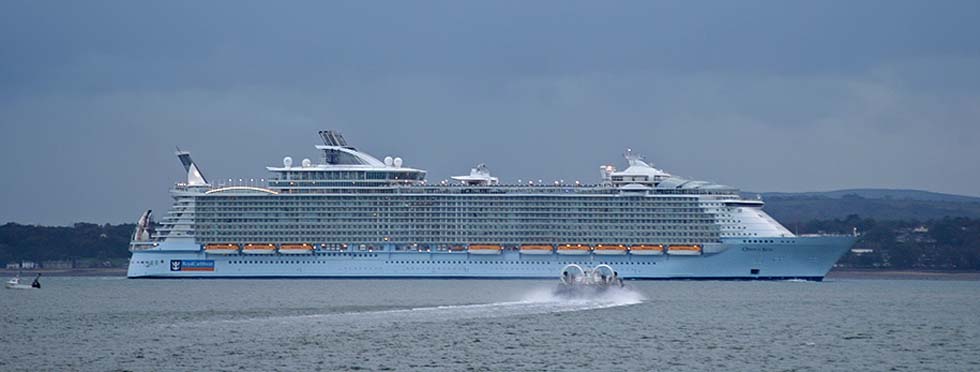
“Oasis of the Seas” near the Isle of Wight on delivery voyage in 2009 (Makele90, via Wikimedia)
In February 2011, the news “Royal Caribbean unveils $2 billion order” has been published. The magazine Ferries reported the preliminary order for two mega ships at Meyer Werft, renowned already for the futuristic newbuilds of Celebrity Cruises, the daughter of Royal Caribbean. In May one fixed order and one option for these ‘Project Sunshine’ 158,000-ton ships for 4,100 passengers each was confirmed. The Web site royalcaribbeanblog.com (24 June) commented: “Ships like Project Sunshine will carry substantially more passengers per square foot so that the ship can have optimal fuel efficiency and get a greater return on investment per passenger (…). The new Project Sunshine class ship design is being headed up by Executive VP Harri Kulovaara and chief designer Kelly Gonzalez (…). The Executive Steering Committee is made up of (President) Adam Goldstein, Royal Caribbean Chairman Richard Fain and Harri Kulovaara.” Finally that Quantum class, driven by two Azipods for a maximum speed of 25 knots, was with a gross tonnage of 167,800 world’s second-largest type of passenger ships at that time. Laid out for 4,180 passengers (double occupancy), it is more economic than the Freedom class. Wikipedia has reported that “the Royal Promenade mall down the center of the ship will not be featured in its traditional form”. The “Quantum of the Seas” was delivered in Oct 2014, the “Anthem of the Seas” in 2015, to be followed by the next ship.
Ships commissioned by Royal Caribbean, delivered from 1988:
Sovereign class
Chantiers de l’ Atlantique: “Sovereign of the Seas” (1988/73,192 gt), “Monarch of the Seas” (1991/73,937 gt), “Majesty of the Seas” (1992/73,937 gt). Upgrading started with the first two vessels.
Vision class
Chantiers de l’ Atlantique: “Legend of the Seas” (1995/69,130 gt), “Splendour of the Seas” (1996/69,130 gt), “Rhapsody of the Seas” (1997/78,491 gt), “Vision of the Seas” (1998/78,340 gt). Kvaerner Masa Yards: “Grandeur of the Seas” (1996/73,817 gt), “Enchantment of the Seas” (1997/74,136 gt, in 2005 extended / 81,500 gt).
Voyager class
Kvaerner Masa Yards, 2 Azipods, 1 Fixipod: “Voyager of the Seas” (1999/137,276 gt), “Explorer of the Seas” (1999/137,308 gt), “Adventure of the Seas” (2001), Navigator of the Seas”, “Mariner of the Seas” (2003/138,279 gt each).
Radiance class
Meyer Werft, gas turbine and steam turbine, 2 pods: “Radiance of the Seas” (2001/90,090 gt). 2 gas turbines, 2 pods: “Brilliance of the Seas” (2002), “Serenade of the Seas” (2003), “Jewel of the Seas” (2004/90,090 gt each).
Freedom class
Aker Finnyards (formerly Kvaerner Masa), extended version of the Voyager class: “Freedom of the Seas” (2006), “Liberty of the Seas” (2007), “Independence of the Seas” (2008/154,407 gt each).
Oasis class
STX Europe (formerly Aker Yards), 3 Azipods: “Oasis of the Seas” (2009/ 225,282 gt), “Allure of the Seas” (2010). STX France: “… of the Seas” (2016/227,700 gt), sister “… of the Seas” evaluated.
Quantum class
Meyer Werft, 2 Azipods: “ Quantum of the Seas” (2014/167,800 gt), “Anthem of the Seas” (2015), “Ovation of the Seas” (contract for 2016).
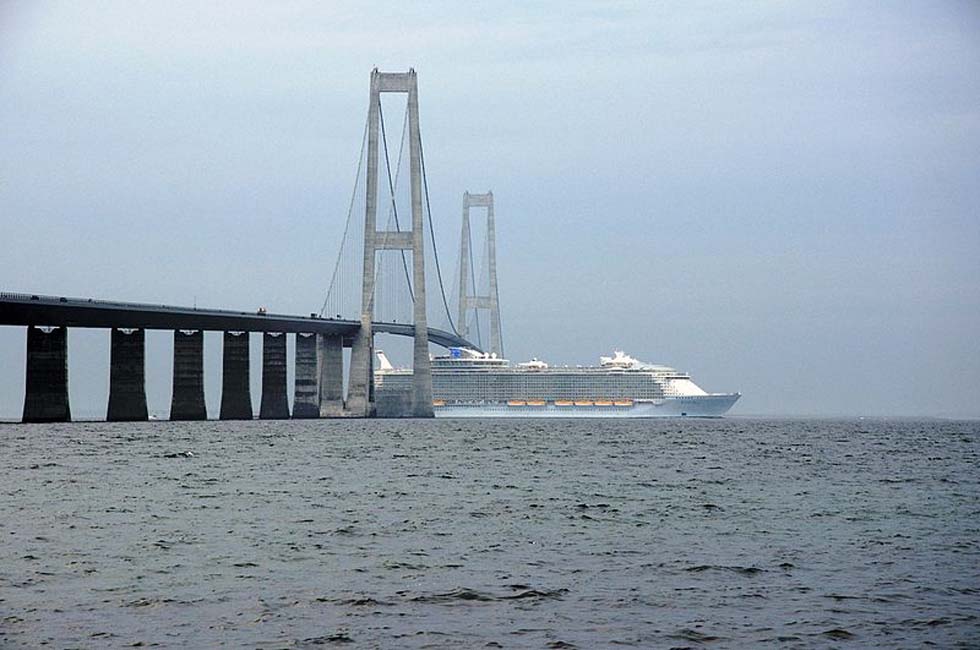
“Allure of the Seas” under the Storebaelts bridge, 30 Oct.2010 (Martin Nikolaj Christensen, via Wikipedia)
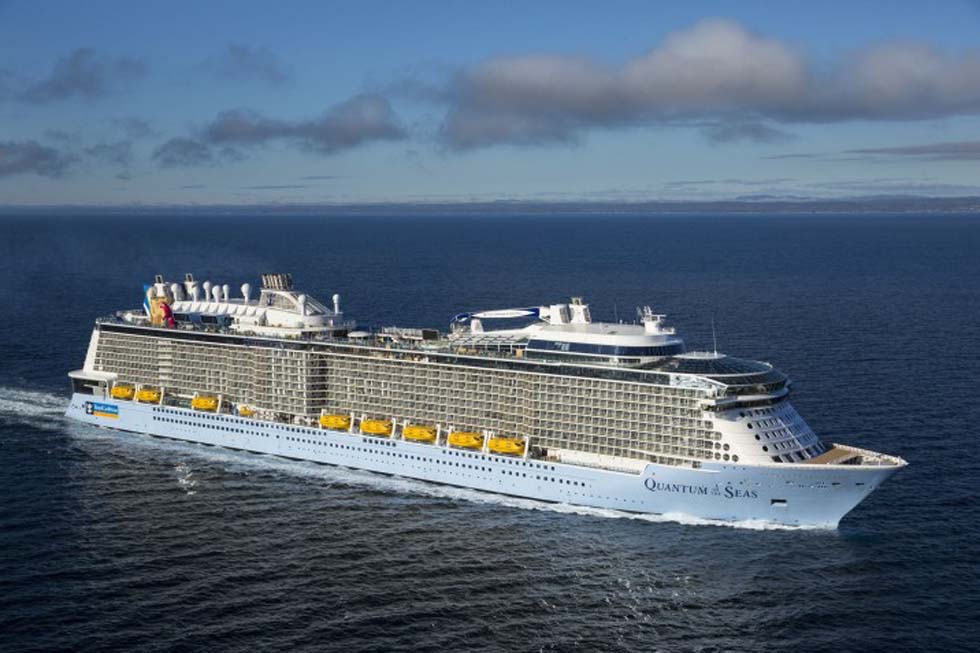
“Quantum of the Seas” (Meyer Werft homepage)
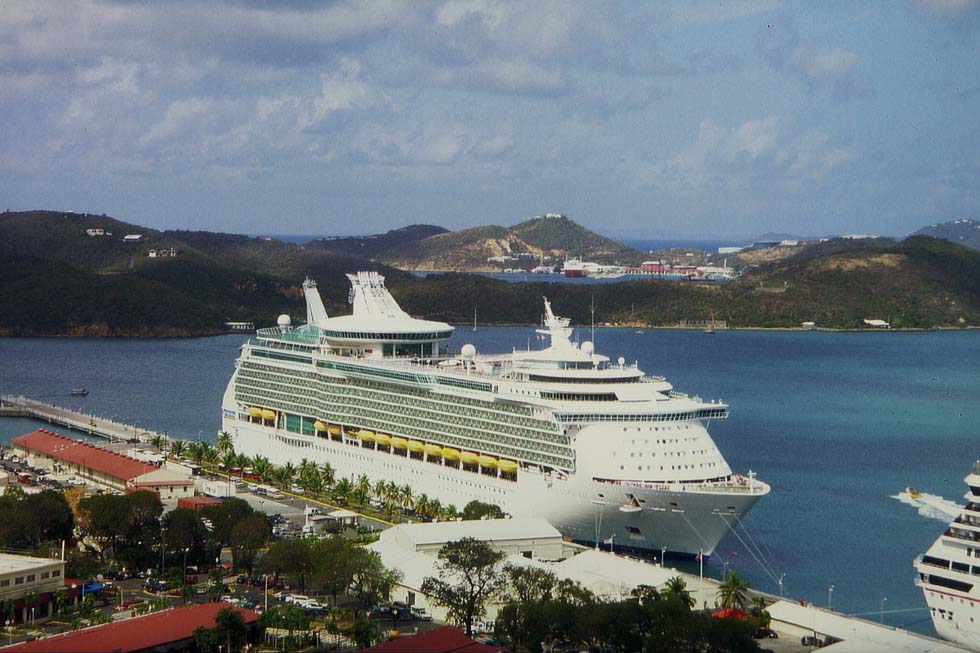
“Navigator of the Seas”, Voyager class, St.Thomas 2007 (WS)
|




